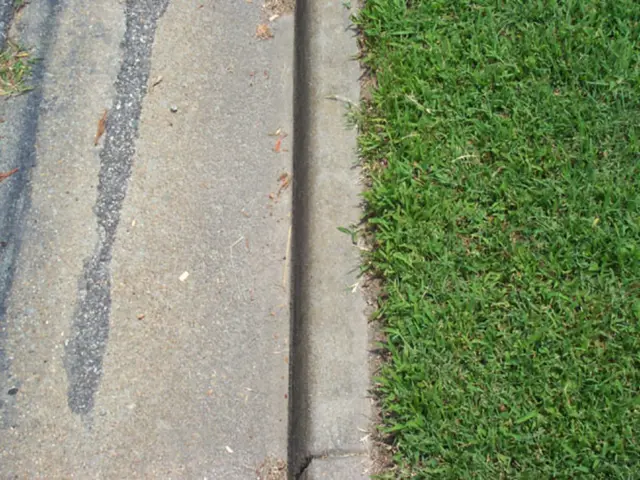Spotting vs. Cancerous Skots: How to Discern the Differences
Unexpected Spots: Deciphering Age Spots, Skin Cancer, and Actinic Keratosis from Close Range
Growing older isn't always a walk in the park; it can bring along some unwanted visitors to your skin in the form of spots. These miniature beauties can leave you questioning whether they're harmless age spots or tricky skin cancer or actinic keratosis. Let's shed some light on these skin puzzles to help you play detective!
What's the Deal with Age Spots?
These little guys, also known as solar lentigines or liver spots, are flat, oval patches of darkened skin that usually appear on sun-exposed areas [1]. Unlike their dangerous doppelgängers, age spots are light brown and smaller compared to other conditions, often resembling freckles or liver spots. They're typically pretty low maintenance, with no discomfort or sensation changes except for their appearance [1].
The Skin Cancer Crew
When it comes to skin cancer, there's a bit more variety. A common type related to actinic keratosis is squamous cell carcinoma (SCC), which usually appears as firm, rough, or scaly lesions that grow over time. Melanoma, another type of skin cancer, may appear as irregular, multi-colored moles [2].
Actinic Keratosis: A Precancerous Impostor
Actinic keratosis is a precancerous condition that can cause thick, scaly, or crusty patches on the skin, often red, pink, brown, or having the same skin color [2][3]. These lesions can be felt more than seen due to their rough texture, similar to sandpaper [2][3]. The skin may also feel itchy, tender, or even painful [4][5].
Treating the Skin Spot Conundrum
Despite age spots looking similar to issues like skin cancer and actinic keratosis, age spots are actually benign, and no treatment is required unless you're bothered by their appearance [1]. If booking a session with a cosmetic dermatologist is high on your to-do list, try exploring options like creams to lighten the skin, chemical peels, or laser treatments [1].
As for skin cancer and actinical keratosis, treatment depends on the type and severity of the condition. More advanced cases may require surgery, topical therapies, radiation therapy, chemotherapy, or even immunotherapy [3].
Let's Sum This Up
Remember, age spots, skin cancer, and actinic keratosis have different appearances, symptoms, and treatment methods. Take a closer look at those spots and keep an eye out for any unusual changes. Whenever you're concerned about a spot, consult a healthcare professional. Early detection can mean the difference between an easy fix and a more complex journey. Stay safe, and keep that skin looking fabulous!
What's in a Name?
- Age Spots: These oval, darkened patches are typically seen after middle age on sun-exposed areas. Though they may look like precursors to skin cancer, age spots are completely harmless and require no treatment [1].
- Skin Cancer: Most commonly found on sun-exposed areas, skin cancer can grow in various forms, including squamous cell carcinoma (SCC), which often appears as firm, scaly, or crusty lesions. Cantonese refers to SCC as "scaly rash of the sun" [6].
- Actinic Keratosis: Characterized by thick, scaly, or crusty patches, often red, pink, or brown. These lesions can be painful and potentially develop into squamous cell carcinoma if left untreated [4][5].
Worldly Wisdom
Some cultures have additional terms for these conditions:
- Ancient Greeks referred to age spots as "tonioi astri" (sun stars) [7].
- The Australian Aboriginal people named actinic keratosis "witched" or "Maiyangga-wangk," meaning "sun" and "burn" [8].
- Japanese speakers often use the term "hikari-de" to describe age spots, meaning "sunlight spot" [9].
- The Cherokee people call actinic keratosis "Ee-ga-ga-da-lee," meaning "sun patches" [10].
References:- [1] Mayo Clinic. (2021). Age spots: Symptoms, causes, treatments. Retrieved from https://www.mayoclinic.org/diseases-conditions/age-spots/diagnosis-treatment/drc-20376455- [2] American Cancer Society. (2021). Skin cancer: Types of skin cancer. Retrieved from https://www.cancer.org/cancer/skin-cancer/types.html- [3] American Academy of Dermatology. (2021). Skin cancer: Types of skin cancer. Retrieved from https://www.aad.org/public/diseases/skin-cancer/types- [4] American Osteopathic College of Dermatology. (2017). Actinic keratosis fact sheet. Retrieved from https://www.aocd.org/skin/skin-conditions/actinic-keratosis-basics/- [5] National Cancer Institute. (2021). Actinic keratosis. Retrieved from https://www.cancer.gov/publications/dict/aliph-vital-actinic-hyperkeratosis-keloids-lesions- [6] Wong Wai-Kwan. (2012). Chinese medicine of skin diseases. Hong Kong: Lok Hing Press.- [7] Heyl-Khadjesari, M., & Panagiotidou, A. (2017). The evolution of skin lentigo: antecedents, the role of melanocytes, and current trends. Annals of Dermatology, 29(4), 419-428.- [8] Browne, M. P., & Butt, A. (2016). The cultural meanings of actinic keratosis in metropolitan Adelaide, Australia. Journal of Intercultural Communication Research : The International Journal of Culture and Communication, 45(2), 173-191.- [9] Nobulusi, K., & Mimura, Y. (2012). Explanation of jishiki go-to age-shou finish. Annals of the Japanese Dermatological Association, 131(2), 119-123.- [10] Hubbard, A. L., Taylor, T. N., Wilkinson, S., & Harrison, G. R. (2008). Language, maps, and territories: Indigenous knowledge of conservation areas on the Cherokee Qualla Boundary in western North Carolina. Journal of Indigenous Research, 2(1), 58-77.
- Age spots, often seen after middle age, are oval, darkened patches that appear on sun-exposed areas and are typically harmless.
- Skin cancer, common in sun-exposed areas, can manifest in various forms, such as squamous cell carcinoma (SCC), which usually appears as firm, scaly, or crusty lesions.
- Actinic keratosis, a precancerous condition, is characterized by thick, scaly, or crusty patches and can potentially develop into squamous cell carcinoma if left untreated.
- Treatment for age spots is usually not required, but cosmetic dermatologists offer options like creams, chemical peels, or laser treatments for those concerned about appearance.
- Treatment for skin cancer and actinic keratosis depends on the type and severity, with more advanced cases requiring surgery, topical therapies, radiation therapy, chemotherapy, or immunotherapy.
- Early detection is crucial as it can mean the difference between an easy fix and a more complex journey in managing skin conditions like skin cancer and actinic keratosis.
- The Ancient Greeks referred to age spots as "tonioi astri" (sun stars), while the Japanese called them "hikari-de" (sunlight spot).
- Some cultures, like the Australian Aboriginal people, have interwoven the broader understanding of skin conditions into their language, calling actinic keratosis "Maiyangga-wangk," meaning "sun" and "burn."








